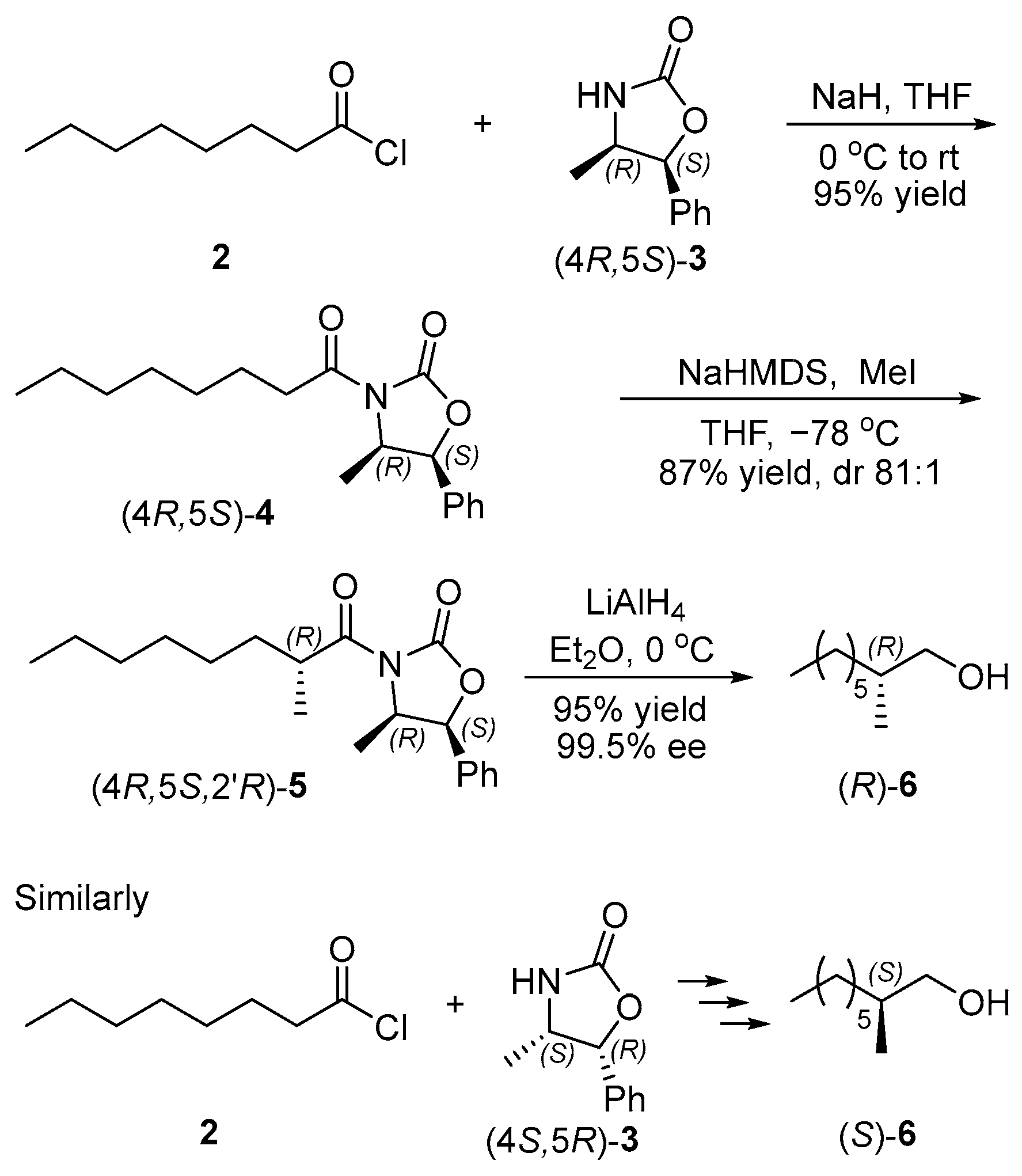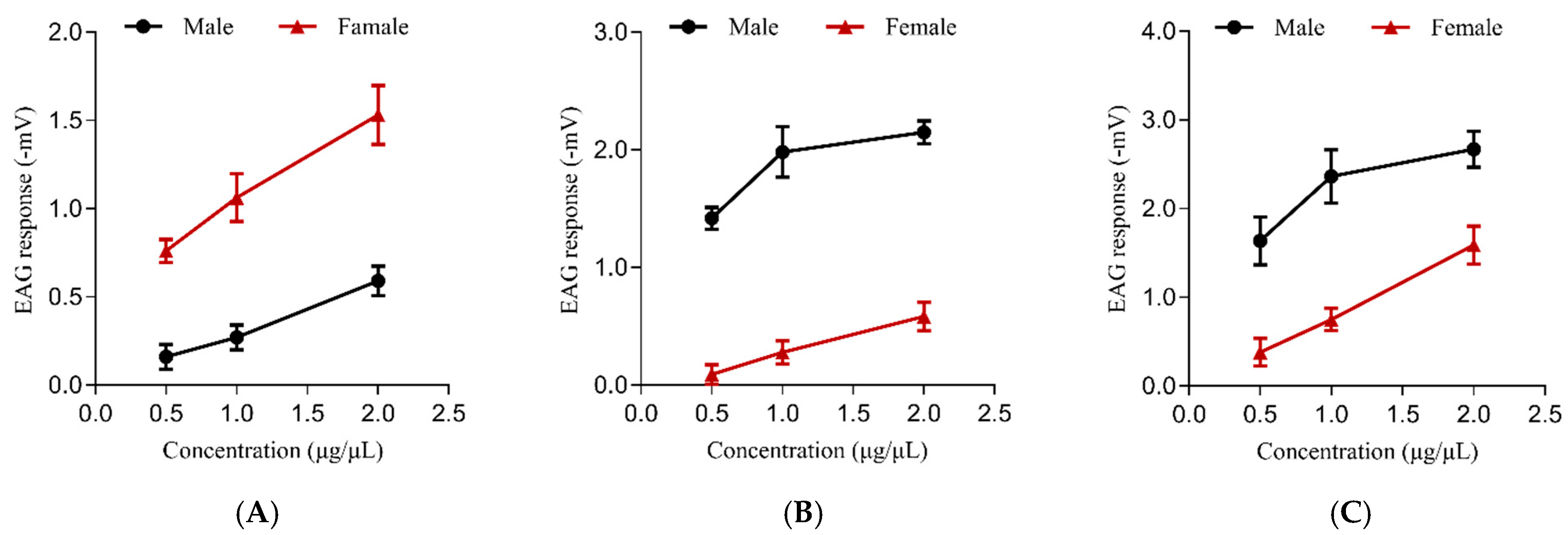Asymmetric Synthesis and Biological Activity of Contact Pheromone of Western Flower Thrips, Frankliniella occidentalis
Abstract
:1. Introduction
2. Results and Discussion
2.1. Chemical Synthesis
2.1.1. Synthesis of Chiral Intermediates (R)- and (S)-6
2.1.2. Synthesis of the Contact Pheromones (R)- and (S)-1
2.2. Biological Activity
2.2.1. Behavioral Activity
2.2.2. Electroantennographic Activity
3. Materials and Methods
3.1. Chemical Synthesis
3.1.1. General Information
3.1.2. Synthesis of Chiral Intermediates (R)- and (S)-6
- (4R,5S)-4-methyl-3-octanoyl-5-phenyloxazolidin-2-one ((4R,5S)-4) (CAS 1341177-96-5)
- (4R,5S)-4-methyl-3-((R)-2-methyloctanoyl)-5-phenyloxazolidin-2-one ((4R,5S,2′R)-5) (new compound)
- (R)-2-methyloctan-1-ol ((R)-6) (CAS 120925-50-0)
- (4S,5R)-4-methyl-3-octanoyl-5-phenyloxazolidin-2-one ((4S,5R)-4) (CAS 1341177-89-6)
- (4S,5R)-4-methyl-3-((S)-2-methyloctanoyl)-5-phenyloxazolidin-2-one ((4S,5R,2S)-5) (new compound)
- (S)-2-methyloctan-1-ol ((S)-6) (CAS 116013-69-5)
3.1.3. Synthesis of the Contact Pheromones (R)- and (S)-1
- (R)-1-bromo-2-methyloctane ((R)-7) (163530-44-7)
- (R)-7-methyltricos-8-ene ((R)-9) (new compound)
- (R)-7-methyltricosane ((R)-1) (new compound)
- (S)-1-bromo-2-methyloctane ((S)-7) (141622-95-9)
- (S)-7-methyltricos-8-ene ((S)-9) (new compound)
- (S)-7-methyltricosane ((S)-1) (CAS 55193-71-0)
3.2. Insects
3.3. Behavioral Activity
3.4. Electroantennographic Activity
3.5. Statistical Analysis
4. Conclusions
Supplementary Materials
Author Contributions
Funding
Institutional Review Board Statement
Informed Consent Statement
Data Availability Statement
Acknowledgments
Conflicts of Interest
References
- Zheng, X.; Yuan, J.; Qian, K.; Tang, Y.; Wang, J.; Zhang, Y.; Feng, J.; Cao, H.; Xu, B.; Zhang, Y.; et al. Identification and RNAi -based function analysis of trehalase family genes in Frankliniella occidentalis (Pergande). Pest Manag. Sci. 2024, 80, 2839–2850. [Google Scholar] [CrossRef] [PubMed]
- Kirk, W.D.J.; Terry, L.I. The spread of the western flower thrips Frankliniella occidentalis (Pergande). Agric. For. Entomol. 2003, 5, 301–310. [Google Scholar] [CrossRef]
- Yudin, L.S.; Cho, J.J.; Mitchell, W.C. Host range of western flower thrips, Frankliniella occidentalis (Thysanoptera: Thripidae), with special reference to Leucaena glauca. Environ. Entomol. 1986, 15, 1292–1295. [Google Scholar] [CrossRef]
- Reitz, S.R.; Gao, Y.L.; Kirk, W.D.J.; Hoddle, M.S.; Leiss, K.A.; Funderburk, J.E. Invasion biology, ecology and management of western flower thrips. Annu. Rev. Entomol. 2020, 65, 17–37. [Google Scholar] [CrossRef] [PubMed]
- Reitz, S.R. Biology and ecology of the western flower thrips (Thysanoptera: Thripidae): The making of a pest. Fla. Entomol. 2009, 92, 7–13. [Google Scholar] [CrossRef]
- Wang, J.; Wan, Y.; Zhang, Y.; Yuan, J.; Zheng, X.; Cao, H.; Qian, K.; Feng, J.; Tang, Y.; Chen, S.; et al. Uridine diphosphate glucosyltransferases are involved in spinosad resistance in western flower thrips Frankliniella occidentalis (Pergande). J. Hazard. Mater. 2024, 466, 133575. [Google Scholar] [CrossRef]
- Gao, Y.; Lei, Z.; Reitz, S.R. Western flower thrips resistance to insecticides: Detection, mechanisms and management strategies. Pest Manag. Sci. 2012, 68, 1111–1121. [Google Scholar] [CrossRef]
- Chul-Young, K.; Khan, F.; Kim, Y. A push-pull strategy to control the western flower thrips, Frankliniella occidentalis, using alarm and aggregation pheromones. PLoS ONE 2023, 18, e0279646. [Google Scholar]
- Khan, F.; Kim, M.; Kim, Y. Greenhouse test of spraying dsRNA to control the western flower thrips, Frankliniella occidentalis, infesting hot peppers. BMC Biotechnol. 2023, 23, 10. [Google Scholar] [CrossRef]
- Olaniran, O.A.; Sudhakar, A.V.S.; Drijfhout, F.P.; Dublon, I.A.N.; Hall, D.R.; Hamilton, J.G.C.; Kirk, W.D.J. A male-predominant cuticular hydrocarbon, 7-methyltricosane, is used as a contact pheromone in the western flower thrips Frankliniella occidentalis. J. Chem. Ecol. 2013, 39, 559–568. [Google Scholar] [CrossRef]
- Hemptinne, J.L.; Lognay, G.; Dixon, A.F.G. Mate recognition in the two-spot ladybird beetle, Adalia bipunctata: Role of chemical and behavioral cues. J. Insect Physiol. 1998, 44, 1163–1171. [Google Scholar] [CrossRef] [PubMed]
- Harre, M.; Trabandt, J.; Westermann, J. Convenient preparation of dimethyl [(3S)-3-methyl-2-oxo-5-octynyl]-phosphonate. Liebigs Ann. Chem. 1989, 1989, 1081–1083. [Google Scholar] [CrossRef]
- Evans, D.A.; Ennis, M.D.; Mathre, D.J. Asymmetric alkylation reactions of chiral imide enolates. A practical approach to the enantioselective synthesis of α-substituted carboxylic acid derivatives. J. Am. Chem. Soc. 1982, 104, 1737–1739. [Google Scholar] [CrossRef]
- Yang, Z.; Jin, X.; Guaciaro, M.; Molino, B.F. Asymmetric synthesis and absolute configuration of streptophenazine G. J. Org. Chem. 2012, 77, 3191–3196. [Google Scholar] [CrossRef] [PubMed]
- Bonazzi, S.; Eidam, O.; Guttinger, S.; Wach, J.-Y.; Zemp, I.; Kutay, U.; Gademann, K. Anguinomycins and derivatives: Total syntheses, modeling, and biological evaluation of the inhibition of Nucleocytoplasmic transport. J. Am. Chem. Soc. 2010, 132, 1432–1442. [Google Scholar] [CrossRef]
- Raffier, L.; Piva, O. Application of the diastereoselective photodeconjugation of α,β-unsaturated esters to the synthesis of gymnastatin H. Beilstein J. Org. Chem. 2011, 7, 151–155. [Google Scholar] [CrossRef]
- Leisering, S.; Riano, I.; Depken, C.; Gross, L.J.; Weber, M.; Lentz, D.; Zimmer, R.; Stark, C.B.W.; Breder, A.; Christmann, M. Synthesis of (+)-Greek tobacco lactone via a diastereoablative epoxidation and a selenium-catalyzed oxidative cyclization. Org. Lett. 2017, 19, 1478–1481. [Google Scholar] [CrossRef]
- Appel, R. Tertiary phosphane/tetrachloromethane, a versatile reagent for chlorination, dehydration, and phosphorus-nitrogen linking. Angew. Chem. Int. Ed. 1975, 14, 801–811. [Google Scholar] [CrossRef]
- Gomes, C.M.B.; Souza, J.P.A.; Millar, J.G.; Zarbin, P.H.G. Determination of the absolute configuration of the male-produced sex pheromone of the stink bug Pellaea stictica, (2R,4R,8R)-2,4,8,13-tetramethyltetradecan-1-ol by stereoselective synthesis coupled with enantiomeric resolution. J. Chem. Ecol. 2022, 48, 502–517. [Google Scholar] [CrossRef]
- Bruns, H.; Herrmann, J.; Mueller, R.; Wang, H.; Wagner Doebler, I.; Schulz, S. Oxygenated N-acyl alanine methyl esters (NAMEs) from the marine bacterium Roseovarius tolerans EL-164. J. Nat. Prod. 2018, 81, 131–139. [Google Scholar] [CrossRef]
- Woo, S.H.; Frechette, S.; Khalil, E.A.; Bouchain, G.; Vaisburg, A.; Bernstein, N.; Moradei, O.; Leit, S.; Allan, M.; Fournel, M.; et al. Structurally simple trichostatin A-like straight chain hydroxamates as potent histone deacetylase inhibitors. J. Med. Chem. 2002, 45, 2877–2885. [Google Scholar] [CrossRef] [PubMed]
- Wittig, G.; Schollkopf, U. Triphenylphosphinemethylene as an olefin-forming reagent. Chem. Ber. 1954, 97, 1318–1330. [Google Scholar] [CrossRef]
- Nakamura, T.; Kubota, K.; Ieki, T.; Hosokawa, S. Stereoselective alkylation of the vinylketene silyl N,O-acetal and its application to the synthesis of mycocerosic acid. Org. Lett. 2016, 18, 132–135. [Google Scholar] [CrossRef] [PubMed]
- Akinyemi, A.O.; Kirk, W.D.J. Experienced males recognise and avoid mating with non-virgin females in the western flower thrips. PLoS ONE 2019, 14, 0224115. [Google Scholar] [CrossRef]
- Terry, L.I.; Gardner, D. Male mating swarms in Frankliniella occidentalis (Pergande) (Thysanoptera: Thripidae). J. Insect Behav. 1990, 3, 133–141. [Google Scholar] [CrossRef]
- Qian, C.; Su, Z.; Xie, W.; Dong, X.; Li, Y.; Yuan, P.; Wang, S.; Wen, X.; Wang, C.; Ma, T. Structure, synthesis, and bioassays of sex pheromone for Pyrausta machaeralis (Lepidoptera: Crambidae). J. Agric. Food Chem. 2024, 72, 3904–3912. [Google Scholar] [CrossRef]
- Xiu, C.; Zhang, F.; Pan, H.; Bian, L.; Luo, Z.; Li, Z.; Fu, N.; Cai, X.; Chen, Z. Evaluation of selected plant volatiles as attractants for the stick tea thrip Dendrothrips minowai in the laboratory and tea plantation. Insects 2022, 13, 509. [Google Scholar] [CrossRef]
- Wang, C.; Li, Y.-H.; Wang, L.; Yang, B.; Wang, G.-R. Development of a new sex attractant via the peripheral coding of pheromones in Mythimna loreyi. J. Agric. Food Chem. 2023, 71, 2795–2803. [Google Scholar] [CrossRef]
- Fujiwara-Tsujii, N.; Yasui, H. Improving contagion and horizontal transmission of entomopathogenic fungi by the white-spotted longicorn beetle, Anoplophora malasiaca, with help of contact sex pheromone. Insects 2021, 12, 383. [Google Scholar] [CrossRef]
- Owston, N.A.; Fu, G.C. Asymmetric alkyl-alkyl cross-couplings of unactivated secondary alkyl electrophiles: Stereoconvergent Suzuki reactions of racemic acylated halohydrins. J. Am. Chem. Soc. 2010, 132, 11908–11909. [Google Scholar] [CrossRef]
- Higgins, C.J.; Myers, J.H. Sex-ratio patterns and population-dynamics of western flower thrips (Thysanoptera: Thripidae). Environ. Entomol. 1992, 21, 322–330. [Google Scholar] [CrossRef]
- Terry, L.I.; Kelly, C.K. Patterns of change in secondary and tertiary sex-ratios of the Terebrantian thrips, Frankliniella occidentalis. Entomol. Exp. Appl. 1993, 66, 213–225. [Google Scholar] [CrossRef]





| Treatment | Control | |||
|---|---|---|---|---|
| (R)-7-Methyltricosane 1 | (S)-7-Methyltricosane 1 | rac-7-Methyltricosane 1 | n-Hexane | |
| Females | ||||
| Median time in vicinity (s) 2 | 38.8 (10, 174) *,b,A | 92.9 (41, 180) ****,ab,A | 103.9 (24, 180) ****,a,A | 2.6 (1, 4) 4 |
| Median no. of abdomen raises 3 | 4.5 (0, 18) *,a | 9.7 (2, 46) **,a | 8.5 (2, 31) **,a | 0.2 (0, 2) |
| Males | ||||
| Median time in vicinity (s) 2 | 85 (15, 160) ***,b,B | 87.3 (15, 180) ***,b,A | 160.8 (83, 180) ****,a,B | 1.6 (1, 3) |
| Median no. of abdomen wags 3 | 1.9 (0, 4) ***,b | 7 (1, 20) ***,a | 3.4 (1, 10) ***,b | 0.1 (0, 1) |
Disclaimer/Publisher’s Note: The statements, opinions and data contained in all publications are solely those of the individual author(s) and contributor(s) and not of MDPI and/or the editor(s). MDPI and/or the editor(s) disclaim responsibility for any injury to people or property resulting from any ideas, methods, instructions or products referred to in the content. |
© 2024 by the authors. Licensee MDPI, Basel, Switzerland. This article is an open access article distributed under the terms and conditions of the Creative Commons Attribution (CC BY) license (https://creativecommons.org/licenses/by/4.0/).
Share and Cite
Lin, C.; Zhu, W.; Wu, S.; Bian, Q.; Zhong, J. Asymmetric Synthesis and Biological Activity of Contact Pheromone of Western Flower Thrips, Frankliniella occidentalis. Int. J. Mol. Sci. 2024, 25, 11699. https://doi.org/10.3390/ijms252111699
Lin C, Zhu W, Wu S, Bian Q, Zhong J. Asymmetric Synthesis and Biological Activity of Contact Pheromone of Western Flower Thrips, Frankliniella occidentalis. International Journal of Molecular Sciences. 2024; 25(21):11699. https://doi.org/10.3390/ijms252111699
Chicago/Turabian StyleLin, Chuanwen, Wenya Zhu, Shuai Wu, Qinghua Bian, and Jiangchun Zhong. 2024. "Asymmetric Synthesis and Biological Activity of Contact Pheromone of Western Flower Thrips, Frankliniella occidentalis" International Journal of Molecular Sciences 25, no. 21: 11699. https://doi.org/10.3390/ijms252111699
APA StyleLin, C., Zhu, W., Wu, S., Bian, Q., & Zhong, J. (2024). Asymmetric Synthesis and Biological Activity of Contact Pheromone of Western Flower Thrips, Frankliniella occidentalis. International Journal of Molecular Sciences, 25(21), 11699. https://doi.org/10.3390/ijms252111699




